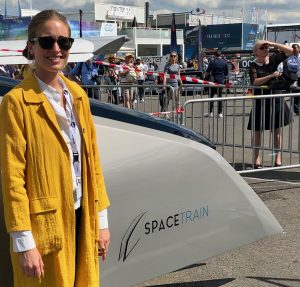Expanding Effective National Infrastructure: The Case of the Spacetrain
As readers of our websites know, we are focused not simply on technology and development but on how concepts of operations and infrastructure both drive technological development but also are changed by the introduction of new technologies.
And for the liberal democracies, shaping more effective infrastructures to face the challenges of 21stcentury defense and security is a core challenge, one which technology can provide solutions, as along as leaders can leverage those opportunities.
A clear case in point is the twin impact of putting in place satellite-based air traffic management systems, and new ground-based transportation technologies which can allow much better use of our geography.
Modern societies are becoming highly concentrated on urban centers rather than being capable of operating in a more dispersed landscape within which rust belts and rural society can become much more effective parts of a national system.
Dispersion and disaggregation not only can make for more pleasant lives for more people, but also provide for much greater redundancy and resilience for societies when dealing with the stress which security or military shocks can provide to the system.
We have focused on how we think vertical farming can provide an enhanced capability for cities to become less reliant on the need to bring food supplies into an urban region, but geographical dispersal is an even more effective means for resiliency.
https://issuu.com/igrownews/docs/washington_times_-_special_section_
https://defense.info/re-thinking-strategy/2018/10/vertical-farming-and-soft-power/
Satellite-based air-traffic management allows for the significant dispersal of the use of smaller airports to connect diverse geographical centers. And will allow as well for the use of smaller planes which are being developed using alternative fuels.
Even more significant would be the development of new approaches to rapid ground transportation which could use existing public right of ways to more effectively link diverse geographical regions.
Such a technology was on display at the Paris Air Show 2019.
When passing various Chalets and Static exhibits, and parked in a corner of the Air Show, there was an odd-looking platform known as the Spacetrain.
After visiting the exhibit on my first day at the PAS 2019, I went back later in the week to discuss with Charlotte Jurus, the Public Affairs Officer, for the company and learned that the platform on display actually is the prototype.

According to the company, “Spacetrain is a shuttle running on air cushions on an inverted T track and propelled by linear induction motors. All its electrical systems are powered by hydrogen fuel cells. The objective of the Spacetrain project is to commercialize its first shuttles by 2025.”
This is a French start-up company based in Paris and in the Orleans region, where the first prototype is being belt and tested. They are looking to use part of an abandoned monorail project, former test track of the engineer Jean Bertain, for the initial tests of their full-scale model and those tests are planned for 2021.
Jurus underscored that the company is leveraging the infrastructure left behind in the Orleans region for a competitor in the TGV project of the 1960s, which in a way, highlights one of the advantages of the project, namely, an ability to leverage what has already been built but abandoned. That project was abandoned in 1974.
The train would operate at a much lower rate of sound generation than the current TGV as well.
The project would allow for the creation of a train able to move 250 passengers on a hydrogen fueled vehicle with the train operating on an air cushion. The “track” would be a concrete bed with the sensors necessary to operate the train at speed and is designed to operate autonomously.
Of course, the system could be used to move freight as well providing for an energy efficient system to reshape the supply grid for a region or a nation.

An operational system of Spacetrains clearly could operate using already established public right of ways and lay down a relatively inexpensive infrastructure on which to operate.
Obviously, it could be of great significance for urban transportation, but even more importantly, could connect the regions which have no TGV in France or in countries like Britain or the United States where rail systems have simply disappeared leaving behind forgotten cities and regions, the possibility could be opened to reinvigorate a much wider variety and range of regions in the national economic space.
According to Spacetrain their technology is based on “a unique energy management strategy, consisting of a smart subsystem. This multi-source energy system (composed of hydrogen fuel cells, lithium-ion batteries and super capacitors) is totally autonomous thanks to its own algorithm to management hybrid resources in real time.”
We wish the team well and would look forward to visiting their facilities in the Orlean region as well on our next visit to France.
The company is in the process of raising capital to move the project forward.

